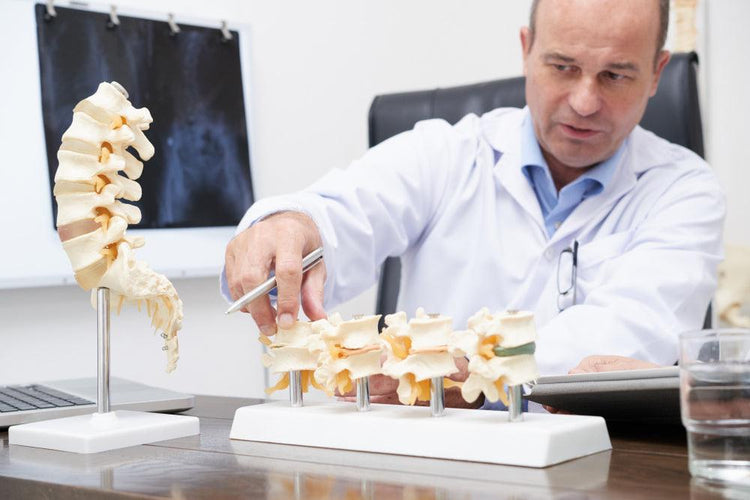
 Instagram
Instagram
Top 5 Mistakes After Knee Replacement

Related products

What is Knee Replacement?
Knee replacement surgeries, medically known as arthroplasties, offer the potential to transform the lives of those suffering from chronic knee pain, often due to conditions such as osteoarthritis. With the UK seeing thousands of these surgeries each year, understanding the post-operative phase is essential for optimal recovery.
The primary goal with knee replacement is to relieve pain and restore function to the joint. People typically undergo knee replacement due to:
- Osteoarthritis: The most common reason, it's a degenerative joint disease where the cartilage that covers the ends of bones in the joint deteriorates over time.
- Rheumatoid Arthritis: An autoimmune disease that can cause joint inflammation and damage.
- Post-traumatic Arthritis: Arthritis that develops after a significant injury to the knee.
- Bone Deformities: Such as bowlegs or knock knees.
- Severe Knee Stiffness or Dysfunction: Which affects daily activities like walking, climbing stairs, or standing up from a seated position.
Candidates for the surgery typically have severe knee pain or stiffness that limits daily activities and moderate to severe knee pain at rest, both of which haven't responded to conservative treatments.
After knee replacement surgery, it is crucial to follow the doctor's recommendation, however some people may make certain mistake without knowing. Let's examine the top five mistakes patients frequently make post-operation, their implications, and how to sidestep them.
What are the 5 Mistakes After Knee Replacement?
After knee replacement, the top mistakes people make include ignoring physical therapy recommendations, overexerting oneself too soon, not managing pain effectively, skipping recommended assistive devices, and not following post-operative care instructions.
1. Neglecting Rehabilitation and Physical Therapy
Rehabilitation following a knee replacement is not just about regaining movement; it's about retraining muscles, ensuring correct posture, and optimising joint function. Some patients, regrettably, either delay or completely skip their physical therapy sessions, believing they can manage on their own. This misconception can result in muscle atrophy, joint stiffness, and a prolonged recovery period.
"A patient's commitment to rehabilitation is directly proportional to the surgical outcome. It's not merely about movement but achieving functional mobility," says Dr Alicia Bennett, a leading orthopaedic surgeon at King's College Hospital, London.
2. Overexerting Themselves Too Soon
While resilience and determination are commendable, rushing the recovery process is detrimental. The newly implanted prosthesis requires time to integrate with the surrounding tissues. Engaging in high-impact activities or not giving the knee adequate rest can lead to complications such as implant loosening or misalignment. This can result in further surgeries down the line. Patients should follow the activity guidelines provided by their surgeons and be patient with their body's healing timeline.

3. Not Taking Pain Management Seriously
Post-operative pain, if not addressed, can inhibit essential movement and exercise. Adequate pain control ensures patients can participate fully in their rehabilitation. Unfortunately, some either neglect their medications, fearing dependence, or fail to communicate if their pain regimen isn't effective.
"Effective pain control is a linchpin in knee replacement recovery. It's not just about comfort but facilitating the necessary physiotherapy without undue distress," says Dr James O'Reilly, a renowned pain management specialist from Liverpool's Spire Hospital.
4. Skipping the Use of Assistive Devices
The period following surgery often requires walking aids to offload the operated knee, ensuring it's not bearing the full weight of the body prematurely. Despite their temporary need, some patients abandon these aids too early, driven by a misplaced sense of recovery. This puts them at risk of falls and undue strain on the surgical site.
"Walking aids are not just support devices; they guide the correct gait pattern, promoting healing and preventing compensatory habits," says Dr Hannah Green, a senior physical therapist from Manchester University NHS Foundation Trust.
5. Neglecting Swelling Management
Post-operative oedema or swelling is a body's natural response to trauma. If not managed effectively, it can cause increased pain, decreased range of motion, and, in severe cases, complications such as wound healing delay or deep vein thrombosis (DVT). Regular cold compresses, use of compression garments, and leg elevation can mitigate this.
"Ignoring swelling can be a precursor to a cascade of complications. It's essential to monitor and address it proactively," warns Dr Fiona Wallace, a vascular specialist from Edinburgh Royal Infirmary.

Common Questions
Undergoing knee replacement surgery, while a significant step towards better mobility and quality of life, brings with it several queries and concerns. Here, we address some of the most frequently asked questions surrounding the procedure and its aftermath.
What can you never do again after knee replacement surgery?
While knee replacement surgeries aim to restore mobility and alleviate pain, there are certain activities that are typically advised against, even after recovery such as high-impact sports like running, jumping, and aggressive twisting movements may be discouraged to preserve the longevity of the implant and prevent undue wear and tear. However, the exact limitations often depend on individual circumstances, the type of prosthesis used, and the surgeon's guidelines.
"It's crucial to remember that while the new knee restores function, it's not invulnerable. Preserving the prosthesis requires certain long-term activity modifications," says Dr Emma Robertson, a leading orthopaedic surgeon from St George's Hospital, London.
What is the most commonly reported problem after Knee Replacement?
Although, most patients experience significant relief following a knee replacement, the most commonly reported problem after knee replacement is post-operative stiffness or limited range of motion. Another occasionally reported issue is a clicking or clunking sound when moving the knee, which, while disconcerting, is often benign. It results from the artificial components moving together.
"While knee replacements have a high success rate, it's essential for patients to promptly communicate any concerns to ensure optimal recovery and detect potential complications early," emphasises Dr Aiden Lewis from Birmingham's Queen Elizabeth Hospital.
What are red flags after knee replacement?
While many symptoms post-surgery are part of the healing process, certain 'red flags' warrant immediate medical attention, including severe pain or swelling that doesn't improve with rest or medications. Signs of infection such as fever, warmth, and redness around the surgical site. Sudden calf pain, which might indicate a deep vein thrombosis (DVT). Shortness of breath or chest pain, which could be signs of a pulmonary embolism – a potential complication of DVT. Any significant changes in the alignment or stability of the knee.
"Patients should always err on the side of caution. If something feels off, it's imperative to seek medical guidance rather than wait," warns Dr Isabelle Thompson, a post-operative care specialist at Royal Liverpool University Hospital.
What is the maximum bend after knee replacement?
Range of motion, particularly the degree of knee bend or flexion, is a crucial measure of success post knee replacement, most surgeons aim for their patients to achieve a flexion of at least 115° to 120°, which is adequate for most daily activities. However, this varies based on the individual's pre-surgery flexibility, the surgical technique, and the rehabilitation process.
"Achieving maximum bend is not just about surgical precision but also post-operative physiotherapy. Diligent rehabilitation can significantly influence the final range of motion," states Dr Neil Patel from the University of Southampton Hospital.
It's worth noting that while these answers provide a general overview, individual experiences and recommendations may vary. Always consult with healthcare professionals about personal concerns related to knee replacement surgery.
How long does the artificial knee last?
On average, modern knee replacements last between 15 to 20 years. However, their longevity can vary based on factors such as the patient's activity level, weight, and overall health.
Is the knee replacement surgery painful?
Any surgical procedure is potentially associated with pain. However, advances in pain management techniques ensure most patients experience minimal discomfort post-operatively. Pain is typically managed with medications and usually decreases significantly over time.
How soon can I return to daily activities after the surgery?
Most patients are able to resume daily activities within six weeks post-surgery, although it may take up to three months for some. Vigorous activities or heavy lifting should be discussed with the orthopaedic surgeon before resuming.
What are the potential complications of the procedure?
While knee replacement surgery is generally safe, it can, like any surgery, have complications, including infections, blood clots, implant problems, continued knee pain, or nerve damage. It's essential to discuss any concerns with a surgeon.
Can I kneel after a knee replacement?
Yes, after knee replacement, kneeling is possible however, some patients might find it uncomfortable, especially in the initial months post-surgery. It's always advisable to consult with a physiotherapist or surgeon about specific post-operative activities.
Is robotic-assisted knee surgery better?
Robotic-assisted knee surgeries are a recent innovation and allow for greater precision. While some studies suggest they may offer better outcomes in terms of alignment and functionality, the best approach depends on individual cases and the surgeon's expertise.
How often should I follow up after the procedure?
Typically, the first follow-up is within 2-6 weeks post-surgery. After that, annual check-ups might be recommended to monitor the implant's performance and the patient's overall health.
Conclusion
After a knee replacement, it's paramount for patients to adhere to post-operative guidelines and be mindful of common pitfalls. Avoiding mistakes such as neglecting physical therapy or overexerting oneself can significantly impact the long-term success of the procedure. Regular consultations with healthcare professionals and diligent post-operative care can lead to a smoother recovery and optimal outcomes.
































 Rated Excellent by 26,523+ Reviews
Rated Excellent by 26,523+ Reviews